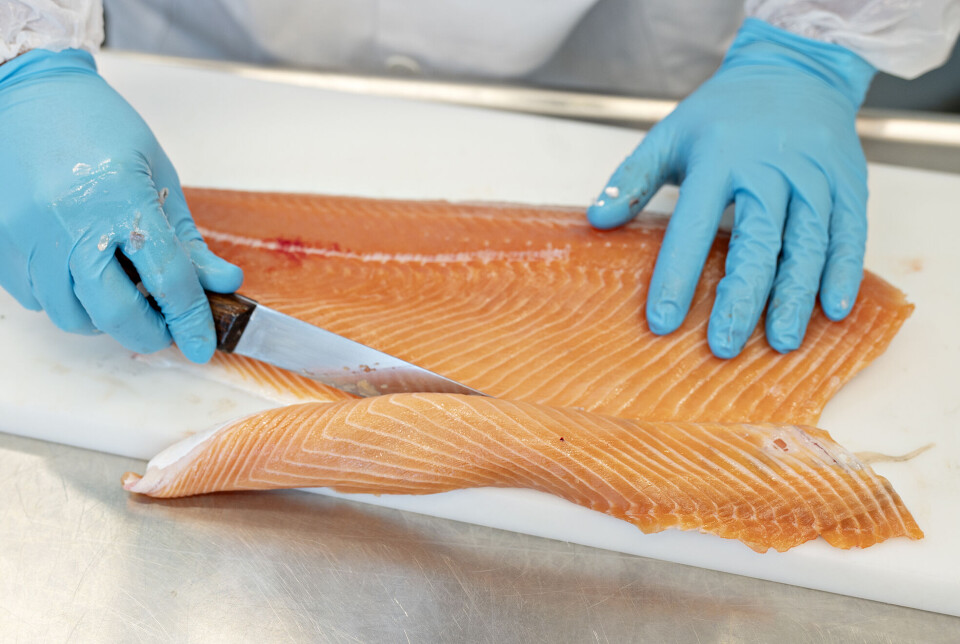THIS CONTENT IS BROUGHT TO YOU BY Nofima The Norwegian Institute of Food, Fisheries and Aquaculture Research - read more
This is what stress does to the colour of salmon
More pigments are being used in salmon feed than before, yet the colour of the fillet has become paler. Researchers have now discovered that stress reduces the colour intensity of fish fillets.

The colour of the fillet is due to the salmon’s ability to store the pigment astaxanthin in its muscle. This pigment is produced by marine algae and is found in marine food chains. It is a powerful antioxidant, and salmon can also use it for synthesis of vitamin A.
Vitamin A is particularly important for the immune system, skin and mucous membranes, fat metabolism, and vision.
Both astaxanthin and vitamin A are added to salmon feed to ensure good health and growth.
The pink colour of the salmon fillet is also important for making it look appealing for the consumer.

“However, the needs for vitamins and antioxidants may change when salmon are exposed to stress, and we still don't know enough about how the environment in which the salmon lives affects the colour of the fillet,” says Trine Ytrestøyl, a senior scientist at Nofima.
Get stressed by lice treatment
Stress leads to the formation of reactive compounds in the body that can damage cells. Antioxidants protect living organisms from damage by neutralising such compounds.
Salmon exposed to stress may therefore have an increased need for antioxidants such as astaxanthin.
Salmon are subjected to considerable stress during their lifetime. Frequent treatments against salmon lice are often necessary. During treatment, the fish are crowded together, and the oxygen level in the water drops. This is extremely stressful for the salmon.
“When we examined data from commercial productions we observed that salmon that had undergone many treatments for sea lice had paler fillets,” says Ytrestøyl.
The importance of feed for fillet colour
Ingredients in the feed can affect the colour of the fillet.
The omega-3 fatty acids EPA and DHA are found in marine feed, meaning feed made from seafood or sea algae. This has a positive effect on the colour of the fillet.
"These fatty acids are reduced in the feed when marine ingredients are replaced with plant-based ingredients,” Ytrestøyl explains.
Vitamin A is also an antioxidant that is abundant in marine food chains. When salmon feed is changed from mainly marine raw materials to plant-based ingredients, the vitamin A content in the feed also decreases.
Ytrestøyl says that salmon may produce more vitamin A from astaxanthin when there is little of it in the feed. But the effect of this on the astaxanthin content in the fillet has not been studied in detail. Nor has it been investigated how stress affects fillet colour.

In an experiment, salmon were given feed containing three different concentrations of vitamin A and two concentrations of astaxanthin.
The levels tested in the experiment reflect the variation found in commercial salmon feed.
The salmon were exposed to stress by being crowded together while the oxygen level in the water was reduced, similar to what happens during lice treatment. This was done several times a week for five weeks.
Too much of a good thing?
When the salmon were not stressed, the highest level of vitamin A in the feed had a negative effect on the fillet colour. Less astaxanthin was absorbed in the intestine and digested when there was a lot of vitamin A in the feed.
This may be a form of regulation to protect the salmon from excessively high levels of vitamin A, which has been shown to be harmful.
The salmon that were exposed to stress had less astaxanthin in the fillet compared to the control group. But there was one exception: Salmon that had received feed with a high content of both vitamin A and astaxanthin did not develop paler fillets as a result of stress.
There was therefore a different effect of high vitamin A content in the feed when the salmon were stressed compared to when they were not exposed to stress.
This may indicate that the need for vitamins and antioxidants changes when the salmon is exposed to a stressful environment.
Nutrition and environment must be considered together
The research results show that exposure to stress reduces fillet colour in salmon, and that the need for antioxidants may change in a stressful environment.
“Stress should be reduced as much as possible, but it cannot be completely eliminated in aquaculture. To ensure the fish have good health and quality, it's important that the amount of vitamins and antioxidants in the feed is adjusted to the challenges the fish face,” says Ytrestøyl.
———
Read the Norwegian version of this article on forskning.no

This content is paid for and presented by Nofima The Norwegian Institute of Food, Fisheries and Aquaculture Research
This content is created by Nofima's communication staff, who use this platform to communicate science and share results from research with the public. Nofima is one of more than 80 owners of ScienceNorway.no. Read more here.
More content from Nofima:
-
Red algae grown in wastewater from fish-farming facilities could become sustainable salmon feed
-
Pumpkins are good for more than just Halloween decorations
-
This is how temperature affects a salmon's health and growth
-
Study: Omega-3 and zinc is a powerful duo for salmon
-
Fish may turn yellow if frozen too fresh
-
Is it better if food is packaged in plastic or paperboard?




































